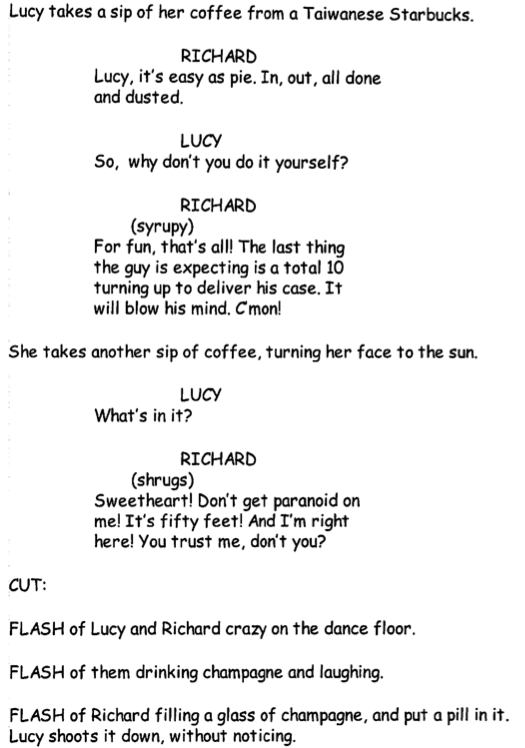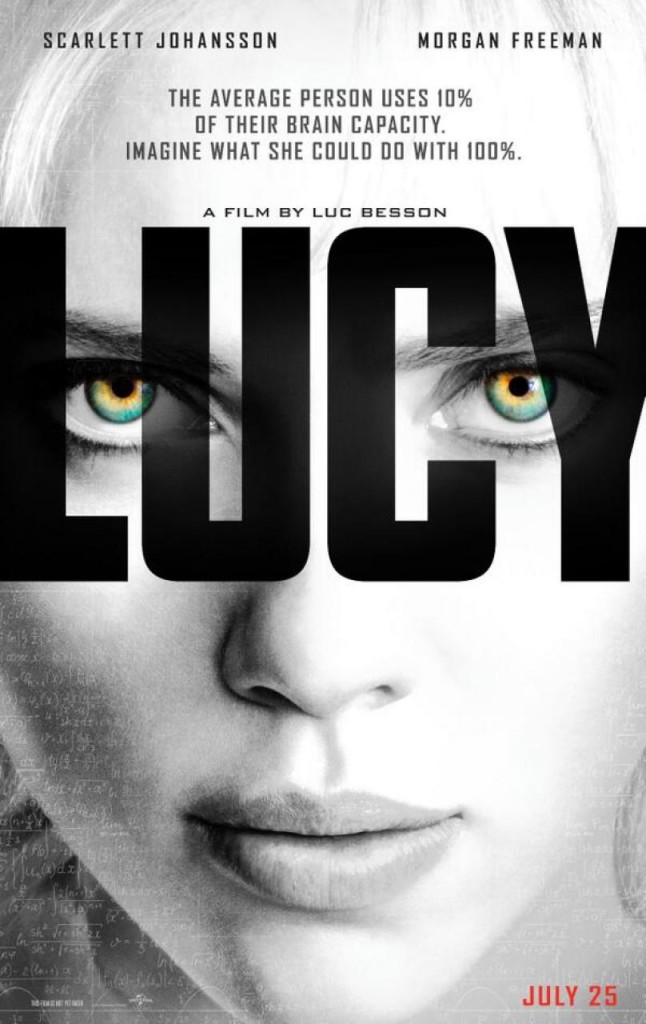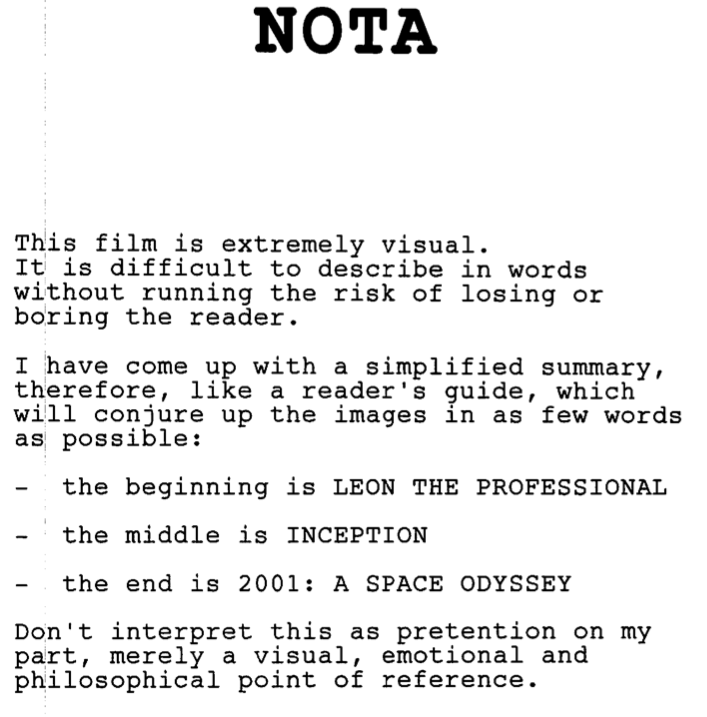Note: The Scriptshadow Newsletter went out Saturday. Check your SPAM and PROMOTIONS folders if you didn’t receive it. To sign up for the Newsletter, head here.
Genre: Action/Sci-fi
Premise: A young woman is forced into being a drug mule. But when the experimental drug she’s carrying inside her ruptures, she starts gaining super-human powers.
About: Taken and Transporter creator Luc Besson is back with his latest action flick, Lucy, an idea he’s had for over 10 years. He’d been looking for a way to mesh action with philosophy for awhile and Scarlett Johansson celebrating her inner badass allowed him to achieve it. Besson said that part of the reason it took him so long to write the script is that, unlike his heroine, he was only using 10% of his brain. The movie came out this weekend and went on to a huge 44 million dollar take, a surprising dominating performance when you consider she was going up against the ultimate testosterone machine, The Rock (in Hercules). Of course, that flick was directed by Brett Ratner, who I’m pretty sure only uses 2% of his brain.
Writer: Luc Besson
Details: 114 pages
I was sure this type of movie had gone out of style. As much as I love GSU, I’m growing tired of the overly simplistic action-thriller use of the model. “Taken” was fresh back when it came out, but after the clone-train hit and I read a million copycats of a) Hero tries to save someone or himself, b) the life of someone they care about or themselves is at stake, and c) they have 48 hours to achieve their mission, I couldn’t muster up enough enthusiasm for the flicks any more.
And the market seemed to agree. Besson’s own GSU film, Lockout, never did anything. The recent Kevin Costner flick, 3 Days to Kill, didn’t do well. All of Crank’s 24-hour man-on-a-mission cousins didn’t do well. And then of course there are all the scripts I’ve seen that no one at the studio level will touch anymore. “It’s Taken on a [insert noun here]” can kill a meeting if you read the room wrong. I was even thinking of writing an article about how the GSU model needed to evolve to survive this change.
And then Lucy shows up, the very embodiment of the simplistic GSU model, and kicks ass. A female mule has an experimental drug leaking into her system, making her smarter and smarter by the minute. She’s got 48 hours before it kills her so she’s got to get to a man who specializes in this sort of thing and transfer to him everything she’s learned before it’s too late.
This straight-forward GSU spec didn’t just do “well,” it fucking blew the competition away, collecting 44 million dollars on a summer weekend with a B-list female carrying the entire movie. That is NOT easy to do.
I don’t know what to make of this. Cause all I saw in the trailers was Scarlett Johansson running around with a gun. To play devil’s advocate, one might say they put a new spin on the action-thriller formula (Lucy becomes in tune with 100% of her brain’s capacity, allowing her to become a “realistic” super-hero). But I’ve seen a ton of that “We only use 10% of our brain” stuff in movies and scripts over the past decade. “Wanted” did it. “Limitless” did it. I thought it was old hat.
Maybe Lucy just lucked out and opened on the perfect weekend, when she had ZERO competition (note to Hollywood, if you want zero competition, find the weekend Brett Ratner’s movie opens). I mean if we’re speaking of ideas that feel played out, look no further than Hercules. Didn’t they just make a Hercules movie earlier this year? This isn’t the 50s.
I give it to Besson. He writes fun scripts. And when I say “fun,” I really mean it! “Lucy” was written in comic sans! That’s a first for a professional script. It also opened with this after its title page:
I don’t think you can get away with this if you’re an amateur. People would laugh at you for being presumptuous. But since Besson has a track record, it’s allowed. And I have to admit, it worked. I was using those films for reference while I was reading, so I could picture how this would look. It’s too bad amateurs can’t do this because being able to explain the style in which you hope your movie will be shot can be the difference between two totally different movies in the reader’s head.
As for the story itself, it’s typical Besson. Once we get to the action, we don’t stop. And with Lucy, we get to the action immediately. A sketchy guy convinces his one-night stand, Lucy, to go deliver a suitcase to someone named “Mr. Wang” for him. Why anyone would deliver a mysterious suitcase to a guy named “Mr. Wang” for someone they just met last night is beyond me. But Lucy does it.
That leads to her finding out some super-heroin-crack is in the suitcase. Mr. Wang makes her mule it to Los Angeles, but the packet inside her starts leaking, and whatever this stuff is, it starts unleashing a chemical that opens up your brain, turning you into an exponential Einstein.
At first Lucy just thinks clearer. But then she starts seeing the vibrations around people, which allows her to read their minds. She can use satellites to see through the internet bringing her into offices halfway around the world, using the vibrations of the matter in those offices to literally see what’s happening in them. Soon she’s manipulating matter, so she can “use the force,” picking objects up and putting them down without ever touching them.
It’s all pretty cool stuff. But this is the reason I thought these movies were dead. With so much centered around the action and the gimmickry, we don’t ever get to know anybody. Personally, I loved how they took their time in Taken. It’s one of the reasons I think that film is the standard for the straight-forward simplistic action-thriller. We actually got to know the dad and the daughter before she was captured, and therefore we CARED about him saving her.
I knew very little about Lucy when she was kidnapped and learned only slightly more over the course of the film. That’s why a film like this gets 57% on Rotten Tomatoes. The critics go there and they see a film that feels fun, that feels visual and kinetic, exactly what a film is supposed to be. But because they don’t ever get to know any of the characters, they leave feeling empty, like what they just saw was a dream.
That’s exactly how I felt after reading this. I was like, “Hmm, this would be a fun movie to watch.” But halfway through this review and I was already forgetting what happened.

Comic Sans font! The future of screenwriting??
Ironically, Besson didn’t even nail the GSU model. I wasn’t sure what Lucy’s main goal was for most of the second act (it turned out to be getting to Professor Morgan Freeman to tell him about her discoveries before she died). That felt like a weak goal. Who cares if she gets this information to Red or not? What happens if she doesn’t? Nothing. That’s the very definition of no stakes.
I honestly didn’t expect this to make more than 30 million dollars in its entire run. But I learned something here. One of the most common pieces of advice screenwriters receive is to find a fresh “TWIST” on a tried-and-true genre. It’s the key to your script being “familiar but different.”
Here’s what nobody talks about though. Is how MUCH of a twist you need. Because if it’s not enough of a twist, then it feels exactly like the genre you’re trying to update. If it’s too much of a twist, it’s no longer within the genre’s target zone and feels eccentric. Nobody really knows where that twist range begins and where it ends.
I thought for sure the whole “10% of your brain” thing wasn’t enough of a twist. But I was wrong. It turns out Besson squeaked it in just past the minimum threshold. I wish I could tell you where that range is, but it’s one of those things that can’t be quantified. This is where craft is thrown out the window and artistry takes center stage. It’s up to you to decide how far you should go. If you nail it and fall right smack dab in the center of that range, you’re golden. If not, that’s probably why you’re not getting enough read requests.
[ ] what the hell did I just read?
[ ] wasn’t for me
[x] worth the read
[ ] impressive
[ ] genius
What I learned: One way to mix up GSU is to start your script with a mystery or two. So instead of jumping into the goal immediately, use the first act to create a “mystery” storyline where the reader’s trying to figure out what’s going on. Then, at the end of the first act, institute the main goal that will drive the rest of the story. So here, we start with the mystery of “What’s in the suitcase?” This leads to a second mystery. Lucy is knocked out by the goons and wakes up with a surgical scar on her stomach. What’s happened to her? She finds out that she’s being used as a mule. Once this mystery is over, she has her goal. Find the other mules before their cargo is transferred, then get to the professor to give him the knowledge she’s gained before she dies. Like I said before, the goal that drives this story is pretty weak, but the use of mysteries at the outset was well done, and pulled us into the story right away.



